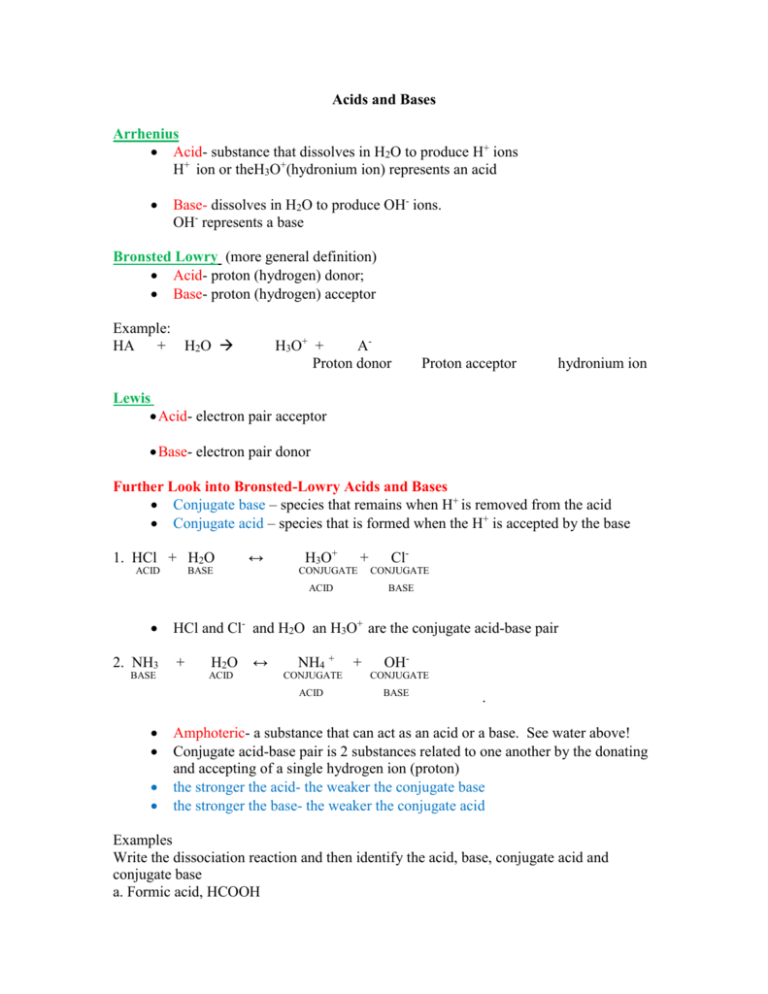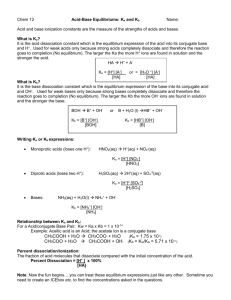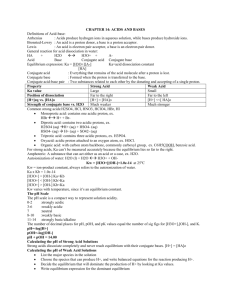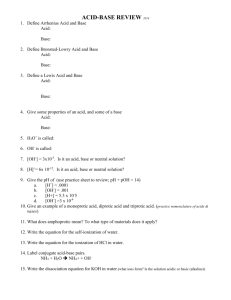Acids and Bases
advertisement

Acids and Bases Arrhenius Acid- substance that dissolves in H2O to produce H+ ions H+ ion or theH3O+(hydronium ion) represents an acid Base- dissolves in H2O to produce OH- ions. OH- represents a base Bronsted Lowry (more general definition) Acid- proton (hydrogen) donor; Base- proton (hydrogen) acceptor Example: HA + H2O H3O+ + AProton donor Proton acceptor hydronium ion Lewis Acid- electron pair acceptor Base- electron pair donor Further Look into Bronsted-Lowry Acids and Bases Conjugate base – species that remains when H+ is removed from the acid Conjugate acid – species that is formed when the H+ is accepted by the base 1. HCl + H2O ACID ↔ BASE H3O+ + CONJUGATE ACID 2. NH3 BASE CONJUGATE BASE HCl and Cl- and H2O an H3O+ are the conjugate acid-base pair + H2O ACID ↔ NH4 + CONJUGATE ACID Cl- + OHCONJUGATE BASE . Amphoteric- a substance that can act as an acid or a base. See water above! Conjugate acid-base pair is 2 substances related to one another by the donating and accepting of a single hydrogen ion (proton) the stronger the acid- the weaker the conjugate base the stronger the base- the weaker the conjugate acid Examples Write the dissociation reaction and then identify the acid, base, conjugate acid and conjugate base a. Formic acid, HCOOH b. Perchloric acid There is a competition between the two bases: HA + H2O H3O+ + A- If H2O is a much stronger base than A-, equilibrium will move to the right, most of the acid will dissolve into ions. If A- is much stronger than H2O, equilibrium will move to the left, most of the acid will remain as molecules. Acid and Base Strengths Strength is determined by the equilibrium position of the reaction Strong acid- equilibrium lies far to the right- all original acid has dissociated(ionized) at equilibrium Examples to memorize – only 7!! HCl + HI, HBr, HCl, HNO3, H2SO4, HClO3, HClO4 H2O H3O+ + Cl- Weak Acid – equilibrium lies far to the left- almost all the original acid is in molecule form and it only ionizes or dissociates to a small extent ( mixture of molecules and ions) Examples: organic acids and ALL others not in the above list HC2H3O2 + H2 O H3O+ + C2H3O2- Strong base- equilibrium lies far to the right- all the original base has dissociated(ionized) at equilibrium Examples to memorize- group I and II soluble hydroxides (Li, Na, K,…..) (Ba, Sr, Ca) NaOH + H2O Na+ + OH- Weak base- equilibrium lies far to the left- almost all the original base is in molecule form and it only ionizes or dissociates to a small extent Examples: ammonia, organic bases and all other NH3 + H2O NH4+ + OHTo write an equilibrium expression for a WEAK acid or WEAK base: from above examples Remember the pure liquid water is left out of expression- concentration will remain the same in a dilute solution Example: Write the equilibrium expression for each: a. Formic acid, HCOOH b. Perchloric acid + -( HCOOH(aq) ↔ H (aq) + COOH aq) HClO4(aq) ↔ H+(aq) + ClO4 -(aq) Acid dissociation constant HC2H3O2 (aq) ↔ H+(aq) + C2H3O2-(aq) Ka = [H3O+][ C2H3O2-] HC2H3O2 Ka = [H+][ C2H3O2-] HC2H3O2 or if Ka > 1 the equilibrium position favors the products if Ka < 1 the equilibrium position favors the reactants Base dissociation constant NH3(aq) + H2O(l) ↔ NH4+(aq) + OH- (aq) Kb = [NH4+][OH-] [NH3] Auto ionization of water 1 water molecule can donate a hydrogen ion(proton) to another water molecule only 1 out of every 109 molecules will ionize SO pure water – almost entirely water molecules H2O + H2O H3O+ + OH- Kw = [H3O+][OH-] or Kw = [H+][OH-] Ion product constant Ion Product Constant does vary with temperature Kw at 25 ºC Pure water Acidic Basic [H] = [OH-] [H+] > [OH-] [H+] < [OH-] H+ =1.0 x 10-7 M H+ > 1 x 10-7 M H+ < 1 x 10-7 M = 1.0 x 10-14 M2 Examples a. Calculate [H+] if [OH-]= 9.3 x 10-4 M Is the solution acidic, basic, or neutral? b. Calculate both the [H+] or [OH-] concentrations if the solution is neutral c. Calculate [OH-] if [H+]= 6.7 x 10-11 M Is the solution acidic, basic, or neutral? pH SCALE Indicate the strengths of acid or base (range from 1-14); easier number to work with Acid (1-6) Neutral (7) Base (7-14) pH= -log [H+] Example: What is the pH of [H+] = 1.0 x 10-7 M HCl PH = - log(1.0 x 10-7) - (-7.00) = 7.00 **** sig figs on logs are special: the number of decimal places in the log equals to the number of sig figs in the original number Other Relationships connected to pH pOH = -log [OH-] and Example: Fill in the blanks pH pOH 6.88 13.08 [H+] 14= pH + pOH [OH-] Acid, Base, neutral 1.3 x 10-7 1.0 x 10-7 To calculate pH of strong acid and base complete ionization; do the above to get your answer focus on the major species - minor species like water can be ignored if their H+ contribution is very small compared to the major species and vice versa in calculating the pH of .10 M HCl the contribution of water (10-7) can be ignored in calculating the pH of 1.0 x 10-12 HNO3, the [H+] contributed by the autoionization of water will be much larger and the contribution of the 1.0 x 10-12 HNO3 can be ignored be careful with bases because some strong bases will release 2 ions when it dissociates ie. .30 M NaOH is .30 M Na+ and .30 M OH- where as .30 Ba(OH)2 is .30 M Ba+ and .60 M OH with bases, you use pOH = -log[OH-] and then 14 = pH + pOH Example Calculate the pH of a 5.0 x 10-2 M NaOH solution. Example Calculate the pH of a solution made by putting 4.63 g LiOH into water and diluting to a total volume of 400 ml. Example Calculate the pH and the [OH-] of a 5.0 x 10-3M HClO4 solution Ka values Ka >>>> 1 Ka <<<< 1 strong acid [H+] = [ HA] weak acid [H+] <<<< [ HA] Property Ka value Strong Acid large Weak Acid small Position of the dissociation (ionization) equilibrium Far to right Far to left Equilibrium [H+] compared to[HA] [H+] ≈ [HA]0 [H+] << [HA]0 Strength of conjugate base compared to water A- is a much weaker conjugate base than water A- is a much stronger conjugate base than water To Calculate pH of weak acid– Must use equilibrium expression 1. Determine the major species (ions) in solution 2. Choose which one that can produces the most H+ and write down the equations for the reaction. 3. Using the equilibrium constants, decide which one wills dominate- compare Ka to Kw. 4. Write down the equilibrium expression of dominant species 5. Use ICE table: List (initial), define changes, determine [equilibrium] by subtracting into expression. 6. Solve for x “easy way” by assuming [HA]0 -x = [HA]0 5% rule - if X / [HA]0 x 100 is less than 5% then we can safely assume [HA]0- x ≈ [HA]0 This actually has another name in this chapter: % ionization = [H+]/ [initial HA] x 100 7. Calculate [H+] and pH using the equation pH = -log[H+] Example: Calculate the pH of 1.00 M solution of hypochlorous acid (HOCl, Ka = 3.5 x 10-8) Example: Calculate the pH of a .500 M solution of formic acid, HCOOH (Ka = 1.77 x 10-4)? Example: The value for Ka = 7.45 x 10-4 for citric acid, C6H10O8. Calculate the pH of .200 M of citric acid. Calculating the pH of a mixture of weak acids Follow same steps as before; pick the predominant species that will produce the [H+] ions Example Calculate the pH of a solution that contains 1.00 M HCN (Ka = 6.2 x 10-2) and 5.00 M HNO2 (Ka = 4.0 x 10-4). Also calculate the concentration of cyanide ions (CN-) in this solution at equilibrium. Example Calculate the pH of a mixture of 2.00 M formic acid, HCOOH (Ka = 1.77 x 10-4) and 1.50 M bromic acid, HOBr (Ka = 2.06 x 10-9). What is the concentration of both the hypobromite ion (OBr-) and the hydroxide ions(OH-) at the equilibrium? % dissociation relationship to Ka % = amount dissociated (M) / initial concentration (M) x 100 Calculate the % dissociation of acetic acid (Ka = 1.8 x 10-5) for each of the following: a. 1.00 M HC2H3O2 b. .100 M HC2H3O2 For a weak acid solution, as [HA] decreases, [H+] decreases BUT % dissociation increases! One more example: In a 1.00 M HC3H5O3, the % dissociation is 3.7%, calculate the Ka for the acid. Polyprotic Acids H2SO4, H3PO4…… Always dissociate stepwise First H+ ion comes off easy - Ka for first H+ is much larger than second; denoted as Ka1 > Ka2 > Ka3 ….. Example: H2CO3 H+ + HCO3-1 Ka = 4.3 x 10-7 -1 + -2 HCO3 H + CO3 Ka = 5.6 x 10-11 Usually only the 1st Ka value makes a significant contribution of [H+]; exception is H2SO4 (STRONG) only in dilute (less than 1.0 M) solutions of H2SO4 does the second dissociation contribute significantly to [H+] Example: H2CO3 H+ + HCO3-1 Ka = 4.3 x 10-7 HCO3-1 H+ + CO3-2 Ka = 5.6 x 10-11 Example Calculate the pH of a 5.0 M H3PO4 solution and the equilibrium concentrations of H3PO4, H2PO4-, HPO4-2, PO4-3 Example Using the following Ka values, calculate the pH of a 1.40 M H2C2O4 solution and the equilibrium concentrations of H2C2O4, HC2O4-1, C2O4-2 and OH- Sulfuric Acid***** unique because it’s the only polyprotic acid that is strong Strong 1st dissociation Weak 2nd dissociation H2SO4 HSO4-1 + H+ HSO4-1 SO4-2 + H+ Ka = large Ka= 1.2 x 10-2 Example: Calculate the pH of a 1.0 M H2SO4 solution. ***** For a concentrated solution of sulfuric acid (1.0 M or higher) Ka1 provides enough information – [H+] is mostly from 1st step. For dilute solutions, 2nd step does make a significant contribution to H+ ions Example- Calculate the pH of 1.00 x 10-2 M H2SO4 To Calculate pH of weak base– Must use equilibrium expression Weak bases react with water removing protons from water Use Kb dissociation constants Complete the same set of rules set for the calculation of pH of a weak acid Use pOH to convert to pH Example Calculate the pH of a 15.0 M solution of NH3 (Kb = 1.8 x 10-5 ) Calculate the pH of 1.0 M solution of methylamine CH3NH2 (Kb = 4.38 x 10-4 ) Relationship between Ka and Kb NH4+ NH3 + H+ NH3 + H2O NH4+ + OH------------------------------------------H2O H + + OHKa = [NH3][ H+] [NH4+] Kb = [NH4+][ OH-] [NH3] By multiplying Ka and Kb you will get Kw = [H+][OH-] So Kw = Ka x Kb Example Calculate Ka or Kb and write the reaction with water for each of the following aqueous ions a. NO2-1 (Ka HNO2= 4.0 x 10-4) b. C6H5NH3 (Ka C6H5NH3= 3.8 x 10-10) Acid-Base Properties of Salt Solutions Salts can be acidic or basic and/or neutral Remember when salts dissolve in water, they completely dissociate; all salts are strong electrolytes Some ions can react with water- hydrolysis to form a weak base or acid Whether the anion of a salt reacts with water to produce hydroxide ions depends on the strength of the acid to which it is the conjugate. To identify the acid, add a H and determine its strength Whether the cation of a salt reacts with water to produce hydrogen ions depends on the strength of the base to which it is the conjugate. To identify the base, add a OH and determine its strength Neutral Solution Is a weak conjugate base - ion from a strong acid SALT + ion form a strong base NO EFFECT ON pH -do not hydrolyze pH = 7 Is a weak conjugate acid Example: KCl Basic Solution Is a strong conjugate base - ion from a weak acid SALT + ion form a strong base WILL BE BASIC pH > 7 no effect Example: NaF F- + H2O HF + OH- Acidic Solution No effect - ion from a strong acid SALT + ion form a weak base WILL BE ACIDIC pH < 7 Is a strong conjugate acid Example: NH4Cl NH4+ + H2O NH3 + H3O+ WHAT IF: Is a strong conjugate base - ion from a weak acid SALT + ion form a weak base Is a strong conjugate acid DEPENDS ON Ka and Kb If Ka > Kb its acidic If Ka = Kb its neutral If Ka < Kb its basic Example: NH4F Example Predict whether each of the following salts will create an ACIDIC, BASIC, or Neutral soln a. Na3PO4 b. KI c. HC5H5NCl d. NH4F To determine the pH of a salt solution Determine the type of salt- add H ion to anion and OH ion to cation Use equation to write equilibrium expression and then ice tables Example: Calculate pH of a .100 M salt solution of NH4Cl ( Ka= 5.6 x 10-10) Example Calculate the pH of a .500 M NaNO2 solution (Ka= 4.0 x 10-4) Example Calculate the pH of a .10 M NH4Cl solution (Kb= 1.8 x 10-5) Factors that Affect Acid Strength Any molecule with a H is a potential acid 2 factors: the polarity of the H-X bond, and strength of the H-X bond 1. the polarity of the H-X bond 2. strength of the H-X bond Molecule H-F H-Cl H-Br H-I Bond strength (kJ/mol) 565 427 363 295 Bond polarity Most polar 2nd most polar 2nd least polar Least polar Acid Strength in water Weak Strong Strong strong In binary Acids ( hydrogen and one other element) DOWN a group, strength is the most important factor: As you go down a group, the size of the atom gets larger and the strength decreases and acidity increases The stronger the H-X bond in a binary acid, the less acidic. Explains HF which is highly polar- more energy needed to break the bonds than in the other hydrogen halides which are all considered strong More polar H-F > H-Cl> H-Br > H-I less polar ACROSS a row, bond strengths do not change as much so Bond polarity is more important. As you go across a row, the electronegativity increases and acidity increases Oxy acids ( one or more O-H bonds) Molecule HClO HClO2 HClO3 HClO4 Ka value 3.5 x 10-8 1.2 x 10-2 ~1 Large (~107) The greater the electronegativity of the central atom that has the O-H bond attached to it, the more acidic because the O-H bond is more polar, favoring the loss of the H+ Also, the more oxygen added to the central atom of an oxyacid, the greater the pull of electron density away from the O-H bond, easier to remove the hydrogen HClO is less acidic than HClO4 Which is the stronger acid? H2TeO4 or H2SO4 Acid Base Properties of Oxides acidic oxides - form from elements with high electronegativities - nonmetallic (covalent) oxides - SO2 : SO2(g) + H2O(l) H2SO3(aq) - CO2 : CO2(g) + H2O(l) H2CO3(aq) basic oxides - metallic oxides - CaO(s) + H2O(l) Ca(OH)2(aq) - K2O(s) + H2O(l) 2KOH(aq) The Lewis Acid-Base Model a Lewis acid is an electron pair acceptor and a Lewis base is an electron pair donor example: NH3







